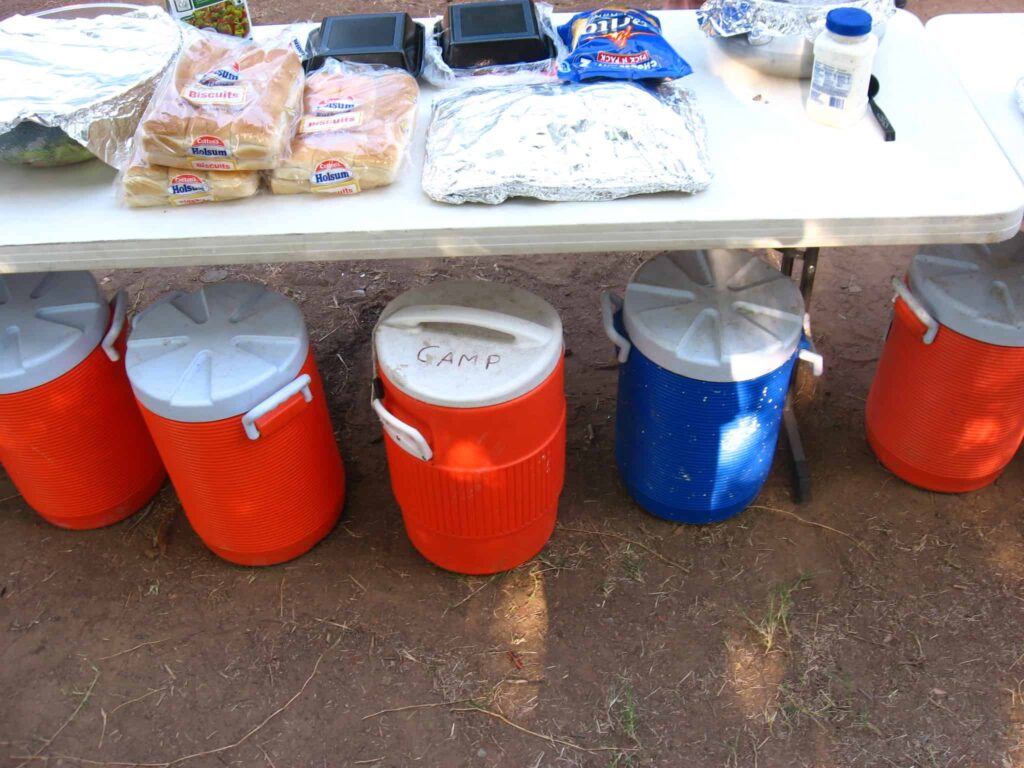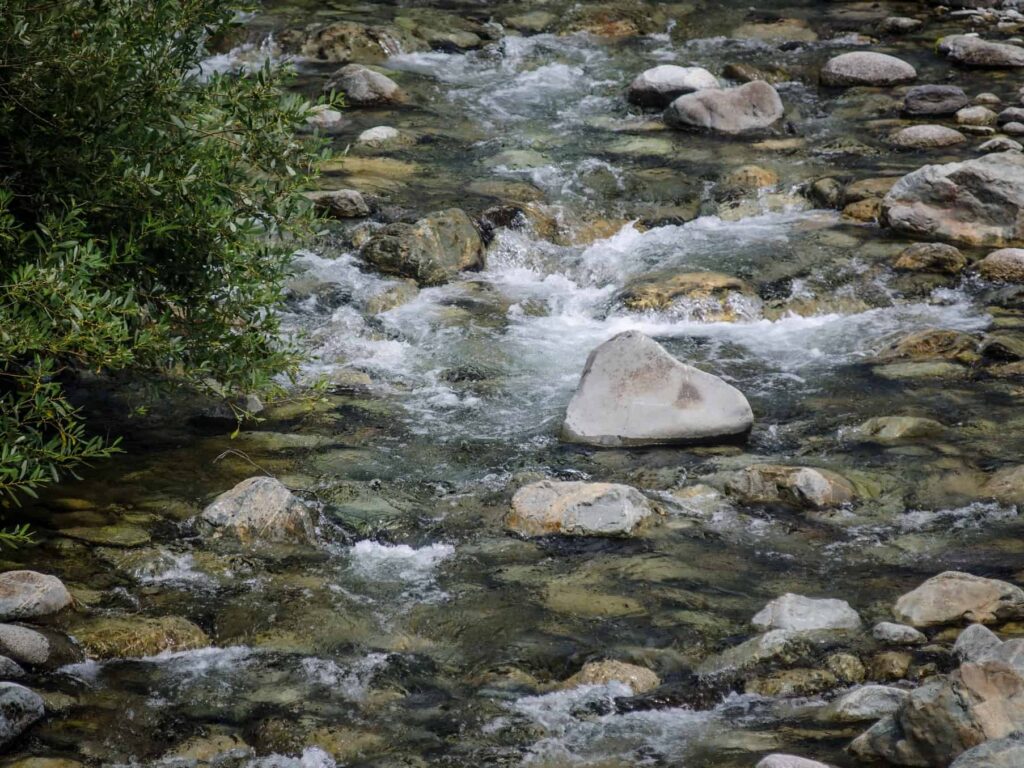Last updated on February 27th, 2023 at 05:27 pm
Water is not only one of the most important needs of survival, but is also crucial for other aspects of camping. Aside from drinking, water will need to be used for cleaning and cooking. Because of this, you may be wondering how much water to bring per day camping so that you have enough.
Here, we discuss how much water to bring on your camping trip according to your unique needs, as well as how to pack and find water.
Campers need at least 1.5 gal. for drinking per person per day
The amount of water you need per person per day can vary depending on your climate and activity level. However, as a general rule you will need to bring about 1.5 gallons for drinking water per person per day minimum.
To add to this, you’ll likely need an additional gallon for cooking, washing your hands, etc…
Because of this, roughly 2.5 gallons per day at camp is necessary to keep your hiking and exploring performance on track and to prevent dehydration.
Dehydration is a very real concern, especially in remote areas. And while dehydration is more common in hot climates due to sweat, it can easily happen in cold climates, especially if you’re doing rigorous hikes.
Symptoms of dehydration include:
- Dry, chapped lips
- Dark yellow urine
- Muscle cramps
- Headache and/or dizziness
- Increased heart rate
If you’re experiencing any of these symptoms, it’s important to get water as quickly as possible.
How Your Activity Level Affects Water Needs

As we mentioned earlier, the amount of activity and how strenuous it is can also cause you to need more drinking water. How much water to bring per day camping will vary if you are an avid hiker versus if you’re more of a relax and chill kind of camper.
During activity, our bodies use more water as we perspire in order to keep us cool. This is also why hiking in hot climates, such as tropical or desert climates, can result in more water loss.
The higher the temperature or the more rigorous the activity, the more water we lose.
This is why it helps to look at the forecast if you’ll be fast packing, hiking tough elevations, or camping in hot or humid conditions. Also consider whether you’ll be doing long hikes (6 or more hours) or short hikes.
Carrying an extra 1-2 liters on hikes is a good safety practice, especially if the hikes are rigorous or in very high temperatures.
One trick you can do, which is especially valuable for short hikes, is to front-load water, drinking 500 ml early in the day before setting off. This starts you off in a super-hydrated state, so you can sip smaller amounts as you go.
Finally, if you’re camping in hot weather, an appropriate sleep system can also help reduce the body’s water loss through perspiration. We’ve found the Best Sleeping Bag for Hot Weather to help you sleep cool.
How to Pack Water for Camping

The most popular method of carrying water is in traditional water bottles. While these are decent for short hikes, they can be bulky and hard to pack due to their rigidity.
Luckily there are other efficient options, including:
- Soft and/or collapsible water bottles. These bottles are more lightweight and can be stored easily, due to their collapsibility. They aren’t as durable as hard water bottles, but can make up for this with their lightweight and soft nature.
- Hydration bladders. These soft water holders are able to fit into designated pockets and can also be strapped to other areas of your pack. This may allow you to carry more water overall.
- Soft water reservoir. These are designed to carry 2-3 days worth of water. While carrying this amount of water will be tough any way you slice it, a reservoir can help make it easier. They can also be strapped to areas of your pack, allowing for more storage.
When carrying water, also be sure to try and carry it as close to your center of gravity as possible. This will help you keep your balance as well as reduce your amount of back strain.
How Much Water Do You Need for Cooking

Much of the dried foods we bring on camping trips in order to conserve space and weight need water to be cooked. Items like pasta, grains, beans, soup, rice, rations, etc… all require water to make a meal.
Plus, water will be required during clean up, even if you choose a minimalist setup!
Prepare to bring at least 1 gallon of water per person, per day of camping for cooking.
Other Water Sources at Camp

However, aside from bringing your own, many campsites offer different types of water sources for campers.
Water sources you may be able to access while camping include:
Campground spigot
in fact, many campgrounds have water spigots installed where campers can fill up bottles or pots with water. However, it is important not to rely solely on campground water, since it could be turned off or broken.
Importantly, make sure you boil any water from camp spigots. Some campers have experienced backflow, which could contaminate water. We’ve found the best options for portable stoves in our Best Camping Stove post.
Clear, moving rivers

Additionally, clear, moving rivers can also be an excellent source of water. However, you must ensure it is clear and moving in order to reduce bacteria risk.
Even if the water seems pristine, however, you still water to err on the safe side and purify it. Campers can do this easily by:
- UV water purification. UV purification systems designed for camping can be found online and in stores. These are lightweight and easy to use, since you can insert the lights into a bottle or pot of water.
- Boiling water. The rule of thumb for the amount of time to boil water is: one minute at sea level and three minutes at high altitudes.
- Iodine purification. For tablets, follow the instructions on your bottle. For liquid iodine to purify warm water, add 5 drops (0.25 mL) of iodine to 1 liter of water. Mix together and let stand for at least 30 minutes before drinking. For cold water, use the same amount but let stand for 40 minutes.
- Using a Lifestraw. Lifestraw is an amazing product that filters water while you use it. You can sip straight from a stream or fill one of their water bottles and filter as you go.
Keep in mind that you can also use unscented household bleach to purify water. To do this, add 2 drops of bleach to 1 liter of water. Mix the water and let it sit for 30 minutes.
Nearby trailheads
You may also be able to find running water at the start of trailheads, or in the bathroom at a trailhead. If the water is cloudy or you have any doubts, be sure to purify. Of course you don’t want to rely solely on the availability of these options. However, how much water to bring per day camping can be greatly diminished if you have a consistent source.
Can You drink Too Much Water Hiking

Drinking too much water is indeed possible while hiking. When we drink too much water while also sweating, we can lose crucial electrolytes necessary for survival.
The more we sweat and drink water without replenishing electrolytes, the more we lose. This is why it is crucial to consume electrolytes on the trail.
You can grab an electrolyte powder, like Propel, to add to water, drink coconut water, and/or eat fruit like bananas, dates and nuts.
Symptoms of overhydration can include:
- Nausea and vomiting
- Headache
- Confusion or disorientation
- Drowsiness
- Muscle cramps
- Excess urination
- Seizures
How Much Water Do I need for a 15 mile Hike
As mentioned earlier, strenuous activity will greatly impact how much water to bring per day camping. For instance, if you’re looking to do a 15-mile hike and leave your gear at camp, here is the recommended amount of water you may need:
Hikers need roughly 2 cups of water per hour, or about 1 liter every two hours of hiking. Most hikers can complete 15 miles in 6 hours, so depending on your pace, your water needs will be roughly 3 liters.
How Much Water Do You Need to Dry Camp

Dry camping (which is also known as boondocking) is when you camp in an RV or van with no hookups. Typically, this is also done outside of a campground.
Because there is no access to water at a campground, you may want to consider bringing more water than recommended. In general, you want a 1 gallon minimum per person, per day for drinking, with more for washing and cooking.
Hydrate for Happy Camping
Campers have a lot to think about when packing and preparing for their trip. Bringing enough water can be more than just good for comfort, but it’s essential for us to survive and thrive. If campers are hiking or engaging in fun activities during the trip, their water needs will differ.
If you’re preparing for a group camping trip and are unsure if there will be a water source near their site, bring the minimum we’ve described above.
The main thing to keep in mind when it comes to water is that it’s always better to bring too much than not enough. When you take into account the amount of hiking you’ll be doing and your climate, you’ll be able to decide how much is ideal. Generally, 2.5 gallons per person per day is ideal for drinking, cooking, and washing.
About the Author
Sarah Sampsell
Title Image Credit, How Much Water to Bring Per Day Camping: Zachary Collier | (source) | Attribution 2.0 Generic (CC BY 2.0) — reduced file size and image
Image Credit 1, How Much Water to Bring Per Day Camping: Guy Wann | (source) | Attribution 2.0 Generic (CC BY 2.0) — reduced file size and image
Image Credit 2, How Much Water to Bring Per Day Camping: Collin Anderson | (source) | Attribution 2.0 Generic (CC BY 2.0) — reduced file size and image
How Much Water to Bring Per Day Camping, Image Credit 3: Martin Cathrae | (source) | Attribution-ShareAlike 2.0 Generic (CC BY-SA 2.0) — reduced file size and image
How Much Water to Bring Per Day Camping, Image Credit 4: Ted and Jen | (source) | Attribution 2.0 Generic (CC BY 2.0) — reduced file size and image
How Much Water to Bring Per Day Camping, Image Credit 5: U.S. Department of Agriculture | (source) | Public Domain Mark 1.0 — reduced file size and image
How Much Water to Bring Per Day Camping, Image Credit 6: Jeff Moser | (source) | Attribution-NoDerivs 2.0 Generic (CC BY-ND 2.0) — reduced file size and image
Image Credit 7, How Much Water to Bring Per Day Camping: Steve Cyr | (source) | Attribution-ShareAlike 2.0 Generic (CC BY-SA 2.0) — reduced file size and image

